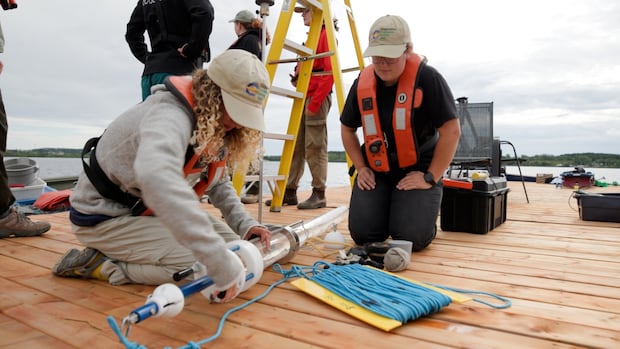To help communities manage blue-green algae blooms, researchers from Laurentian University are looking to the past.
Masters student Mackenzie Hobbs has been collecting sediment from northeastern Ontario lakes to determine how industrialization has affected blue-green algae levels in those waters.
“I think the past is pretty much key to the future,” Hobbs said.
“Because we need to know how far we’ve gone off, like in terms of phosphorus for example. How far we’ve actually exceeded what natural conditions were in the lakes, right?”
Lakes that have high levels of nutrients, such as phosphorus, create conditions that are perfect for cyanobacteria to multiply, and eventually form blue-green algae blooms.
The blooms can produce toxins that can be harmful to humans and animals and sometimes lead to the closing of beaches.
Hobbs said lake sediment provides a number of clues that allows researchers to look back over 200 years, before development and industry would have added nutrients to local waterways.
One of those indicators are chironomids, which are the larval stage of flies and typically live in the sediment.
“They are indicators of dissolved oxygen content in lakes,” Hobbs said. “I’m picking their head capsules out of the sediment and identifying them.”
To determine past phosphorus levels in the lakes, Hobbs said she is also looking at microalgae called diatoms, of which some species thrive in nutrient-rich water. The number of those species found in the historical record would show how much phosphorus was in the water at that time.
Liz Favot, a Laurentian professor who is Hobbs’s supervisor, said that if they discover some lakes have higher levels of phosphorus than they would have had before industrialization, that’s something cities and towns can address.
But her own research has found that some lakes with low nutrient levels still get blue-green algae blooms because of climate change. The cyanobacteria that cause the blooms can also thrive in warmer water.
“If that’s the case, it is very difficult to manage,” said Favot.
Benefits for Espanola
One of the lakes they are studying is Apsey Lake, which is where the town of Espanola draws its municipal drinking water.
Joseph Burke, Espanola’s chief administrative officer, said Hobbs’ research could inform policies around land use planning near the lake.
Burke said there have been three or four blue-green algae blooms on the lake since 2015.
While that’s not as frequent as with some lakes in Sudbury, where there is more development, he said the trend has increased.
“Hopefully [the study will] give us information that will allow us to implement new policies or measures around potentially things like land use planning in the area to help prevent and hopefully turn around the health of the lake,” Burke said.







